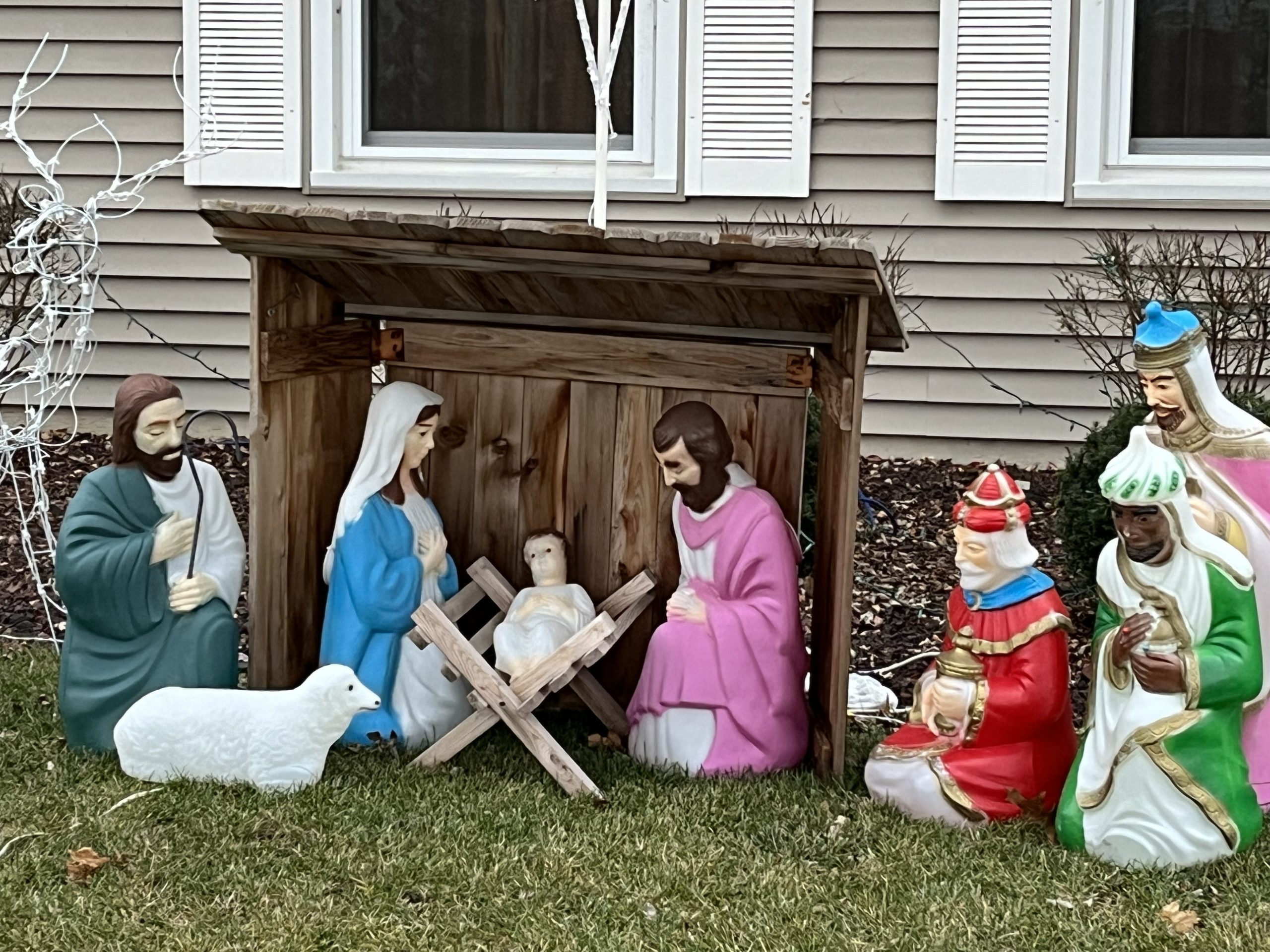When my daughter was very small, she was obsessed with our neighbor’s outdoor nativity scene. Maybe it was the child-sized figures of Mary and the shepherds, or the stories about Jesus she’d heard at church. I remember walking with her once and she ran over to it, all awkward in her toddler snowsuit, and tried to sit next to baby Jesus, knocking over his flimsy “manger” crib. (Sorry, neighbors.)

Not exactly historically accurate. But beloved by my kid.
All over the world, similar nativity scenes are on display in churchyards, in front of homes, in public squares. These displays sometimes cause political controversy and heated discussions about separation of church and state. But to me the real controversy is how these tableaus, and nativity plays that nearly every church will perform, get the story absolutely wrong.
The typical creche, or nativity play, features the lonely holy family, gathered in a stable attended only by cows and sheep, visited by shepherds later in the evening. It also includes the three wisemen.
So, yes, Jesus was born, to Mary. Shepherds showed up. Joseph was there. Animals might have been nearby. That’s about all that’s accurate.
The scene fits a certain narrative, created by years of tradition: heartless innkeepers putting out “No Vacancy” signs, eventually one relenting enough to offer a dirty stable floor to a woman who’s going into labor on the back of donkey.
Too bad it’s not actually what the Bible says.
Jesus was born in a house, not a stable
There is no mention in the bible of an innkeeper, or a barn. Or even a cave, as some have theorized. Also, the wise men showed up months or even a couple of years later, and the Bible says they went to a house, not a barn.
The traditional translation of Luke 2: 6-7 says, “So it was, that while they were there, the days were completed for her to be delivered. And she brought forth her firstborn Son, and wrapped Him in swaddling cloths, and laid Him in a manger, because there was no room for them in the inn.” (NKJV)

A more accurate rendering of the word is found in the NIV and other more recent translations:
“While they were there, the time came for the baby to be born, and she gave birth to her firstborn, a son. She wrapped him in cloths and placed him in a manger, because there was no guest room (kataluma) available for them.” (Luke 2:6-7, NIV)
Also, the idea “while they were there” conveys that Mary did not go into labor during the trip to Bethlehem, but she and Joseph had probably been there for a longer time, and eventually, while they were there, the time came for Jesus to be born.
So the picture of Mary and Joseph wandering the streets of Bethlehem seeking shelter as she’s about to give birth is simply not accurate. Nor is the idea of Joseph delivering a baby in a barn, on his own.
In Bethlehem at that time (and other towns nearby) most people lived in a small house with one room for the family (where they ate, slept, and lived), and a second room for guests–because hospitality was an essential part of the culture. Most houses also had an area where the animals were kept at night. (See this related article)
There were no hotels or even B&B’s as we know them. Inns were often places of ill repute. The culture of the Middle East at that time essentially required that you show hospitality to strangers, and certainly to family. So Joseph, whose family was from Bethlehem, showed up at the door of his relatives. And they welcomed him in—but he and Mary would need to stay in the family room because the guest room was already occupied. And as was common in that culture, the family animals were brought into an adjacent room for the night, keeping them safe and also adding warmth to the house. Their manager, a stone feeding trough, typically stood between the area for the animals and family‘s one-room living quarters. (For illustrations and more detailed explanation, see this excellent article by Ian Paul.)
Why accuracy matters
When the story we tell ourselves doesn’t match the actual truth, we miss out on the point. Mary, a first-time mom who was likely a teenager, gives birth not alone in a barn, but surrounded by the family she’s recently married into, in their home. Women who’d likely delivered plenty of other babies were there to hold her hand and wipe her brow–and be the first ones to welcome the baby. Jesus was born in a house, his birth attended by female aunts and cousins. He probably came into our world in a warm, welcoming, if somewhat crowded extended family home—not a drafty stable. The “manger” was not a rickety wooden crib we see in “nativity scenes” but a stone trough that would be a safe and protective place to put a newborn baby who was swaddled. The story of Jesus’ birth is a story about hospitality, not the lack of it!
I love that in God’s infinite sense of humor, the very first people to behold the Messiah were those at the bottom of the social ladder: shepherds and women. (And by the way, women were also the first witnesses to his resurrection.)
The story of Jesus’ birth, like much of our reading of Scripture, has been colored by our assumptions, by traditions, by art (think medieval paintings of the Nativity that include doe-eyed cows gazing calmly at the Christ child.)
Our reading of Luke, and many other passages, feel influenced by a shame narrative that wrongly tells us Mary and Joseph were embarrassed by the circumstances of Jesus’ birth; they felt outcast, not welcomed.But we put that on the text, when it’s not there. More likely, Joseph’s family were God-fearing people who knew their moral and religious obligation to offer hospitality, no matter what. And when a family member shows up, they of course will throw open the door and offer whatever they can. The cows may have been nearby, but Jesus first cry was likely heard by an overjoyed group of Jewish family members who delighted to see a healthy newborn boy, the sign of God’s blessing. Jesus was welcomed. This season is about our welcome of him, and of others–even if it is inconvenient.
Who are you welcoming this year?
This year, perhaps your house is crowded, and offering hospitality is inconvenient, messy, even difficult.
At Christmas, we, like Jesus’ extended family, are called to offer hospitality even when our guest room is full. Maybe you’re the one staying at a home other than your own. Like Jesus, you’re on the pull-out sofa in the family room. Even if you’re not hosting this Christmas, you can choose to welcome all who gather around the table or the living room with you.
The idea of Jesus in a house instead of a stable captures my imagination. When I first heard this more accurate rendering of the story several years ago, I became as obsessed with it as my daughter had been with the figures in my neighbors’ yard. Jesus is not out in the back shed, he’s in the house. He’s in the middle of a messy family who may have a variety of opinions about his being there, but who set those aside to welcome him to the world. His birth is attended not just by Joseph, but by a group of women, reassuring and helping Mary.
How often do I compartmentalize my faith, putting it out in the shed, separate from my real life? Jesus came into the midst of a family, into a crowded home full of relatives.
This season, as you gather with a crowd of relatives, or even a small group of friends, welcome them as you would Jesus. As Jesus’ earthly family welcomed him.
Another couple of excellent articles on this topic: http://www.reformedtheology.ca/luke2a.htm
http://www.psephizo.com/biblical-studies/preaching-christmas-without-a-stable/


![Lorenzo Monaco (circa 1370–circa 1425) [Public domain], via Wikimedia Commons](https://keriwyattkent.com/wp-content/uploads/2016/12/Lorenzo_Monaco_Geburt_Christi-300x200.jpg)
Great post on a very misunderstood subject.
Yes, yes, yes!!! Love this! :-)
Thanks Leslie! I just discovered your blog today and love it.